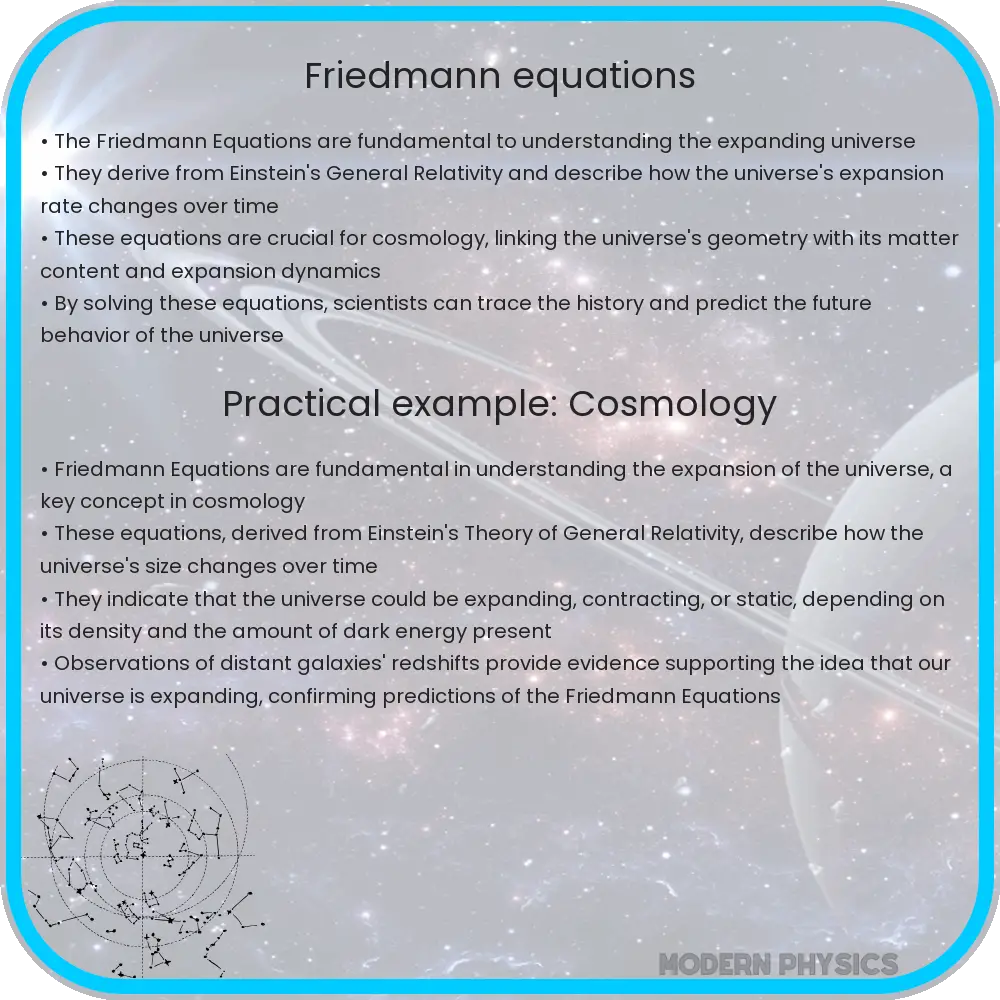Explore the Friedmann Equations and their role in understanding the universe’s expansion, dynamics, and fate, based on general relativity and cosmological observations.

Understanding the Friedmann Equations
The Friedmann Equations, fundamental to cosmological theory, are a set of equations derived by Alexander Friedmann in 1922. These equations describe the universe’s expansion and serve as the core of the Big Bang theory. They provide a framework for understanding the dynamics of the universe, incorporating the principles of general relativity and the cosmological principle, which assumes the universe is homogeneous and isotropic on a large scale.
The Basics of the Friedmann Equations
The Friedmann Equations are based on Einstein’s field equations of general relativity and take into account the metrics of a spatially homogeneous and isotropic universe. They can be expressed in two forms. The first equation relates the rate of expansion of the universe (the Hubble parameter, H) to the total energy density, including matter, radiation, and the cosmological constant (Λ):
\[H^2 = \frac{8\pi G}{3}\rho – \frac{k}{a^2} + \frac{\Lambda}{3}\]
Here, \(H\) is the Hubble parameter, \(G\) is the gravitational constant, \(\rho\) is the total density of the universe, \(k\) is the curvature parameter, \(a\) is the scale factor, and \(\Lambda\) is the cosmological constant.
The second equation addresses the acceleration (or deceleration) of the universe’s expansion, factoring in pressure and the cosmological constant:
\[\frac{\ddot{a}}{a} = -\frac{4\pi G}{3}(\rho + 3p) + \frac{\Lambda}{3}\]
Here, \(\ddot{a}\) represents the acceleration of the scale factor, and \(p\) is the pressure of the content of the universe.
Implications for Universe Dynamics
The Friedmann Equations are critical for cosmology as they describe how the scale factor \(a\) evolves over time, which in turn explains how the universe expands or contracts. This expansion is not uniform and can vary depending on the values of the density \(\rho\), pressure \(p\), and the cosmological constant \(\Lambda\). The fate of the universe, whether it will expand forever, halt, or recollapse, hinges on these parameters.
By analyzing different solutions to these equations, cosmologists can predict the age, structure, and future of the universe. They also provide the theoretical foundation for the Big Bang model and for understanding the cosmic microwave background radiation, the abundance of light elements, and the large-scale structure of the cosmos.
Exploring the Fate of the Universe
The fate of the universe is intricately tied to the parameters in the Friedmann Equations. If the density of the universe exceeds a critical value, it suggests a closed universe that will eventually recollapse in a “Big Crunch. Conversely, if the density is below this critical value, the universe will continue to expand indefinitely, leading to a “Big Freeze. The cosmological constant, \(\Lambda\), adds another layer of complexity, contributing to the accelerated expansion of the universe, as observed in distant supernovae.
Modern Observations and Theoretical Developments
Modern cosmological observations, such as those from the Planck satellite and other telescopic studies, have provided estimates of the cosmological parameters, including the Hubble constant, the average density of matter, and the cosmological constant. These observations support the model of a flat universe that will continue to expand at an accelerated rate due to the presence of dark energy, represented by the cosmological constant \(\Lambda\).
In addition to empirical data, the Friedmann Equations have inspired further theoretical developments in cosmology, including inflationary theory and the study of dark matter and dark energy. These concepts are essential for explaining the universe’s rate of expansion and the distribution of galaxies and other cosmic structures.
Conclusion
The Friedmann Equations serve as the cornerstone of cosmological theory, offering a framework to understand the universe’s past, present, and future. By integrating general relativity with observational cosmology, these equations guide us in exploring the fundamental questions about the universe’s fate and structure. As observational techniques improve and new theoretical models develop, our understanding of the cosmos will continue to evolve, rooted in the foundational principles laid out by Friedmann’s groundbreaking work. Thus, the study of the universe’s expansion not only enlightens us about our cosmic origins but also about the ultimate destiny of all cosmic matter.
